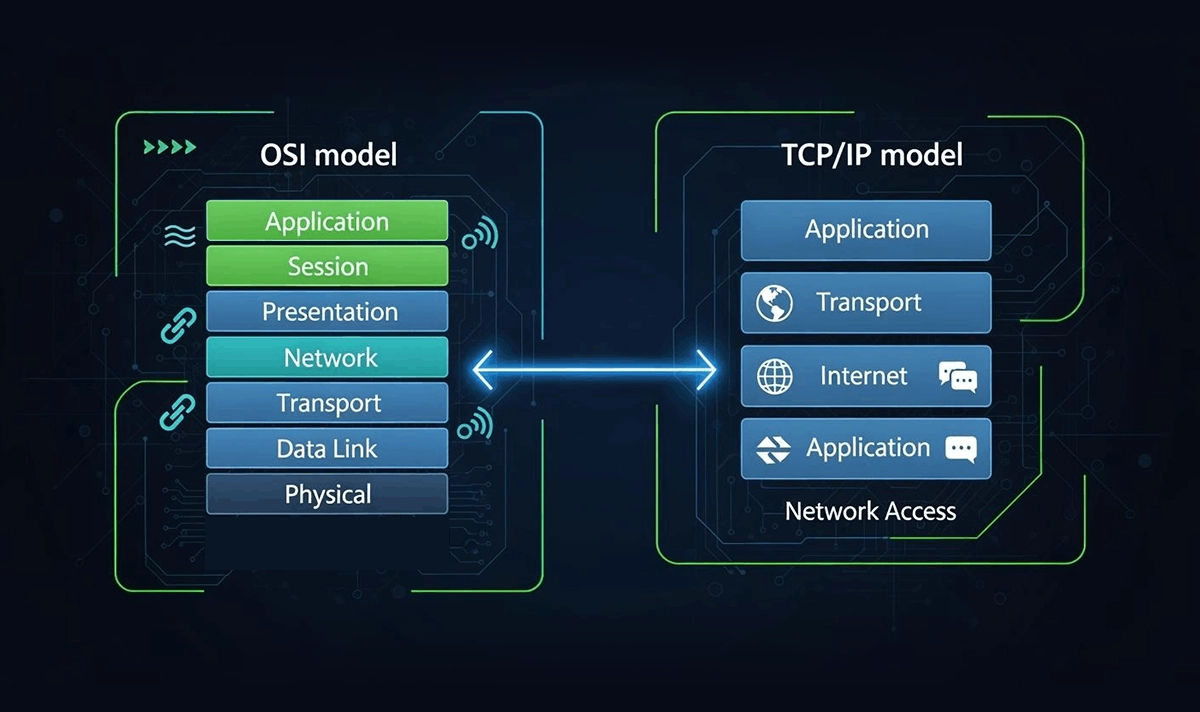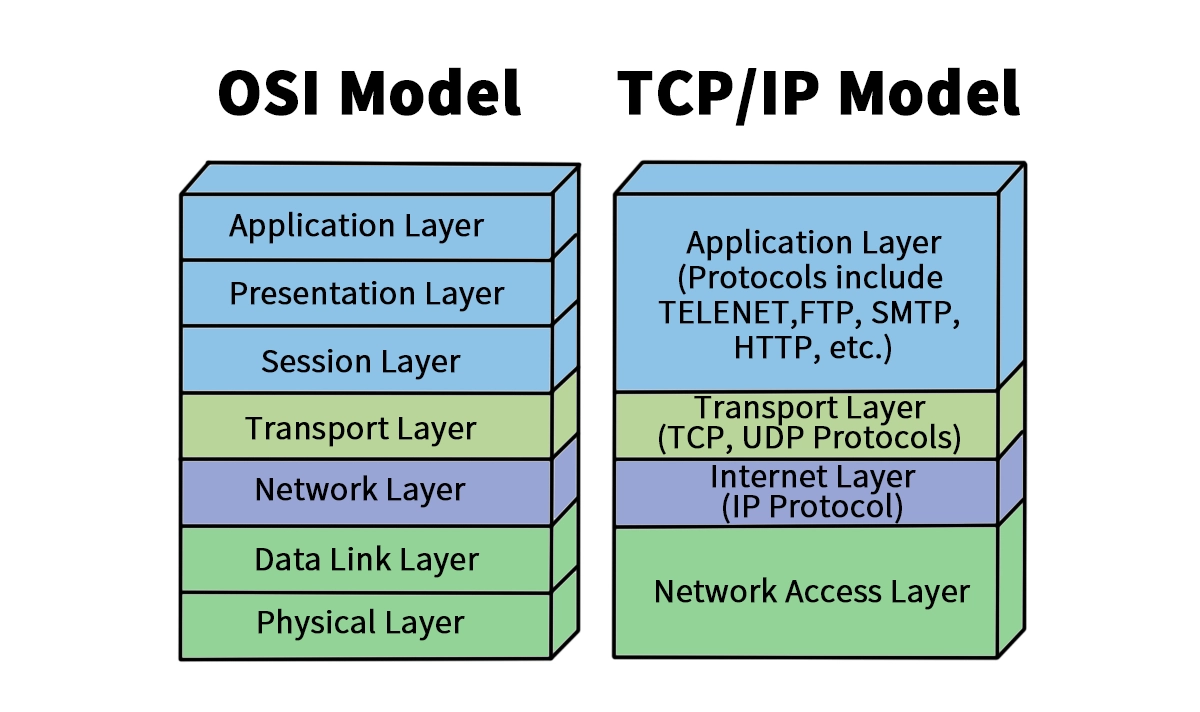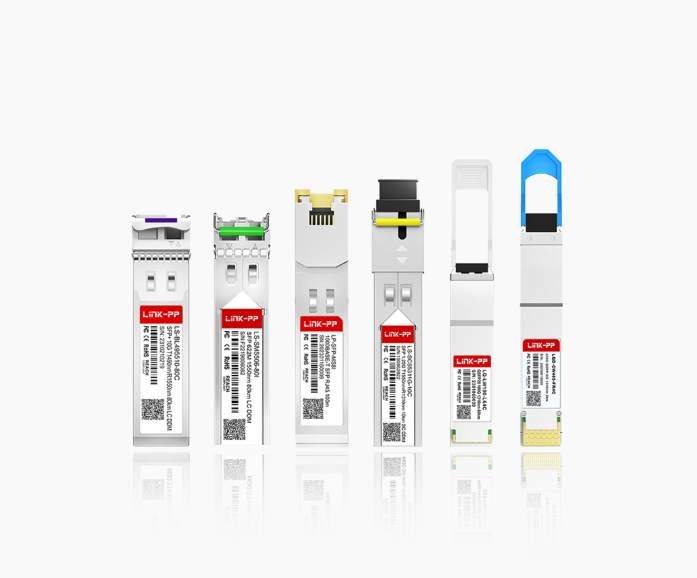
Ever wondered how an email zips from your device to a colleague across the globe in milliseconds? Or how a video stream finds its way to your screen without a hitch? This digital magic is governed by a set of rules called networking models.
For anyone involved in network infrastructure solutions, understanding the two foundational models—OSI and TCP/IP—is crucial. While one is a theoretical masterpiece, the other powers the modern internet. In this deep dive, we'll unravel the layers of both models, compare them side-by-side, and clarify a common point of confusion. We'll also explore how physical components, like the high-speed optical transceivers from LINK-PP, fit into this layered world.
⚔️ Key Takeaways
The OSI model helps you learn about how networks work. It splits the process into seven easy-to-understand layers.
The TCP/IP model is used in real networks today. It has four layers and helps you set up and fix networks.
Use the OSI model when you want to study network ideas. Use the TCP/IP model for real jobs like setting up Wi-Fi or fixing problems.
Both models help you talk about networks. They give you words to use when you talk about problems and answers.
⚔️ The Conceptual Blueprint: The OSI 7-Layer Model
The Open Systems Interconnection (OSI) model was developed by the International Organization for Standardization (ISO) as a conceptual framework. Its goal was to standardize communication systems so that products from different vendors could interoperate. Think of it as the perfect, detailed architectural blueprint for networking.
Let's break down its seven layers:
Physical Layer (Layer 1): This is the hardware. It defines the electrical and physical specifications of the data connection. It's all about bits—sending raw, unstructured raw bit streams over a physical medium (like cables, fibers, or radio waves).
Data Link Layer (Layer 2): This layer takes the bits from the physical layer and groups them into "frames." It handles error detection and flow control and is responsible for node-to-node delivery on the same network segment. Switches operate at this layer.
Network Layer (Layer 3): The primary job here is logical addressing and path determination. It takes data segments and packages them into "packets." Using IP addresses, it figures out the best route to send data from the source to the destination across different networks. Routers are the stars of this layer.
Transport Layer (Layer 4): This layer ensures complete, error-free data transfer. It manages segmentation (breaking data into smaller units), error recovery, and flow control. The two most famous protocols here are TCP (Transmission Control Protocol) for reliable, connection-oriented communication and UDP (User Datagram Protocol) for faster, connectionless communication.
Session Layer (Layer 5): This is the "dialogue controller." It establishes, manages, and terminates connections (sessions) between applications.
Presentation Layer (Layer 6): Think of this as the translator. It ensures data is in a usable format by handling encryption, decryption, and data compression.
Application Layer (Layer 7): This is the layer end-users interact with directly. It provides network services to application software (e.g., web browsers, email clients). Protocols like HTTP, FTP, and SMTP live here.
⚔️ The Practical Workhorse: The TCP/IP 4-Layer Model
While the OSI model was being debated, the TCP/IP model was already being built and used. Also known as the Internet Protocol Suite, it is the set of communications protocols that powers the actual internet. It's less of a theoretical guide and more of a practical implementation.
Its four layers are a condensed version of the OSI model:
Network Access Layer (or Link Layer): This combines the functions of the OSI Physical and Data Link layers. It handles hardware addressing and the protocols needed to access a specific physical network (like Ethernet or Wi-Fi).
Internet Layer: This maps directly to the OSI Network Layer. Its core protocol is the Internet Protocol (IP), which is responsible for IP addressing, routing, and packet fragmentation.
Transport Layer: This is identical in function to the OSI Transport Layer, housing both TCP and UDP protocols.
Application Layer: This is a combination of the OSI Session, Presentation, and Application layers. All the high-level protocols are bundled here.
⚔️ OSI vs TCP/IP: A Head-to-Head Comparison

The best way to understand their relationship is through a direct comparison. This is a common topic for comparing OSI and TCP/IP protocol suites.
Feature | OSI Model | TCP/IP Model |
|---|---|---|
Origin | Developed by ISO (conceptual) | Developed by DARPA (practical) |
Layers | 7 Layers | 4 Layers |
Design Principle | Protocol-independent standard | Protocol-dependent implementation |
Usage | Primarily a theoretical, educational tool | The foundation of the modern internet |
Key Differentiator | Strictly separates services, interfaces, and protocols | Loosely layered, protocols were designed first |
The Core Difference in a Nutshell:
The OSI model is a top-down, theoretical standard. The TCP/IP model is a bottom-up, practical protocol suite that shaped the internet. A great way to remember this is: "OSI describes how networks should work, while TCP/IP describes how they actually do work."
⚔️ Where Do Optical Transceivers Fit In? Bridging the Digital and Physical Worlds
Now, let's connect these abstract layers to a tangible piece of hardware: the optical transceiver. This is a critical component for anyone looking to upgrade data center network performance.
An optical transceiver, like the ones manufactured by LINK-PP, is a device that transmits and receives data. It converts electrical signals from network devices into optical (light) signals for transmission over fiber optic cables, and vice-versa.
So, which layer does it operate at?
It operates squarely at Layer 1 - The Physical Layer. It is the physical interface that implements the "bit transmission" function defined by the networking models. The quality and capability of your transceiver directly impact the speed, distance, and reliability of your entire network infrastructure.
For instance, deploying a LINK-PP SFP28-25G-LR transceiver allows you to establish a high-speed 25 Gigabit Ethernet link over long distances. This single physical layer component enables the billions of bits that form the packets, segments, and data streams of the higher layers to travel reliably.
⚔️ Conclusion: Which Model Should You Use?
So, which model wins? The answer is both.
Use the OSI model for learning and troubleshooting. Its granular 7-layer approach provides a universal language for diagnosing problems. Is it a cable issue (Layer 1)? A routing problem (Layer 3)? Or an application firewall (Layer 7)? The OSI model gives you a clear mental map.
Use the TCP/IP model for real-world implementation. When you configure a router, set up a firewall, or develop a web application, you are working directly with the TCP/IP protocol suite.
Mastering both models gives you a comprehensive understanding, from the theoretical ideal to the practical engine of the internet.
Ready to build or upgrade your network infrastructure? The journey starts with a solid foundation. Whether you're planning a new deployment or looking for reliable components to optimize your existing setup, understanding these models is the first step.
🔗 Explore LINK-PP's range of high-performance, compatible optical transceivers, like the SFP28-25G-LR, designed to deliver the robust physical layer your data demands.
⚔️ FAQ
What is the main difference between the OSI and TCP/IP models?
You use the OSI model for learning and theory. You use the TCP/IP model for building real networks.
Tip: OSI helps you study; TCP/IP helps you work.
Why do most networks use TCP/IP instead of OSI?
You find TCP/IP in most networks because it is simple and works well with the internet. OSI is more detailed, but you use it mainly for teaching and troubleshooting.
Can you use both models together?
You can use both models to understand and fix network problems. You learn with OSI, then apply your knowledge using TCP/IP in real networks.
OSI | TCP/IP |
|---|---|
Learn | Apply |
How do the layers match between OSI and TCP/IP?
You see that some OSI layers combine in TCP/IP. For example, the OSI application, presentation, and session layers become the TCP/IP application layer.
Note: This helps you map problems from one model to the other.




